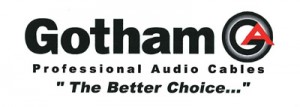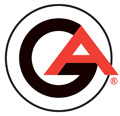GOTHAM CABLE

I first experienced Gotham audio cable in 1989, when we installed a big mix room at Image Recording in Hollywood (now Resonate Studios in Burbank). That top notch facility, operated by John Van Nest and Harry Maslin, was then replacing their Harrison 4032 with a new SSL desk. John and Harry wanted the best of everything in their new room, including the audio cables. After considerable research they chose Gotham multi pair audio cable. Back then it was sold by Gotham Audio–the famous, prestigious New York firm that sold and serviced Neumann and EMT products.
When the spools arrived, it was like nothing we had seen before. The dual shields and complex construction made for slower wiring progress compared to Mogami and Belden cable types we had done, but the greatly superior quality of this quality was obvious. We chose Gotham multipair cable, with its double Reussen shielding and 25 stranded inner conductors, of 38-gauge copper. This was a large installation with a large mixing desk, eight outboard racks, a large recording space with numerous mic panels, some over 100 feet from the console). In addition, tie lines to a distant utility room that contained the plate reverbs several large power amps. It was very important that despite the complexity of the install and the long cable runs, the room would have no hum, buzz, crosstalk, clicking, or RF interference. Upon completion of the install we carefully measured signal to noise ratio and were surprised and delighted with the results. It was one of the quietest rooms we have ever measured, and there were no ground noise or RF issues to debug. John and Harry were thrilled, and in the years to come, a lot of monster hit albums were recorded in Image Studio A!
Gotham audio cable has never been well known like Belden, Mogami, or Canare but over the years many audio professionals have insisted on Gotham for demanding applications and high end installs. I have always felt that it was superior to those brands and I’m very please that Studio Electronics is now a dealer for Gotham cable. This design, with its finely stranded copper wire and supple jacketing assures superb flexibility, easy and fast handling, low memory and reliable, long life. Below, you’ll see more history on Gotham cable, along a summary of cable types that are made, with links to our web store. If you need help choosing cable for a particular application or have any questions, please contact us.
David Kulka
Studio Electronics, Inc.
THE GOTHAM CABLE FAMILY
Gotham manufactures a wide variety of pro audio and video cables. Here’s a short summary of the main categories, with links to our web store. Clicking on a category link will bring up a list of cable types within that category. You can then click on an individual cable type for a detailed description, photo image, and pricing.

Gotham GAC Double Shielded Analog Cables – The best known and most popular types. Most feature double Reussen shielding, though some utilize a foil shield and drain wire. This group includes 2 and 3 conductor microphone cables, small diameter installation cables, special low noise and halogen free types, Star-Quad, Active Loudspeaker, Tube Microphone, 2-Pair Round and Flat types, and Multicore Cable. Other important cables in this group are GAC-7 Tube Microphone Cable,, with 7 conductors and double Reussen shield, and GAC-2111, with an ultra-strong cut resistant jacket (a remake of EMT-2111 mic cable).
GAC-3 triple conductor microphone cable ( See sidebar) – GAC-3 is Gotham’s signature 3-conductor microphone cable, a studio standard for decades. Double 96-conductor shields, with 115db RF rejection. Available in black, traditional gray, and thick jacket versions. We also have a limited supply of new old stock Gotham GAC-3 with a soft brown jacket. (See sidebar)
Gotham DGS Standard Analog Cables – They are standard, single shielded types. This line is more economical than the GAC group. The DGS line includes Unbalanced Coaxial cable, Balanced Single Shield Mic Cable, Small Diameter Installation Cable, Star-Quad, and Multipair Cable.
Gotham Cables for Digital Applications – The Digital line includes coaxial S/PDIF cable, standard and mini AES-EBU, DMX cable (for lighting control and communications), AES-EBU Foil Shield cable, Halogen Free AES-EBU, 2-pair Siamese AES-EBU, and Multipair AES-EBU. Most of these are double shielded cables with very low capacitance. Many consultants and designers specify Gotham digital cable for long cable runs, in both digital and analog applications.
Digital Video Cables and Flexible Speaker Cables – Speaker cables are suitable for high power applications and are available in coaxial and flat types.
Why 3 Conductor Cable for an Audio Signal?
Some Gotham cables utilize 3 conductors, plus a double Reussen shield. Most veteran engineers and studio techs have encountered EMT or Gotham 3 conductor mic cable. Here are the benefits of this unique mic cable construction:
— Grounding/shielding: With the third conductor connected to ground, together with the two shields, RF-rejection is increased to 115dB (20dB better than standard) at 25 kHz. This was confirmed in the November 1994 AES paper by Mr Neil A. Muncy “Noise Susceptibility in Analog + Digital Signal Processing Systems”. Gotham GAC-3 was named the best performing microphone cable available.
— Round Construction: 3-conductor constructions are round constructions, and since the cable has the freedom to move in all directions, especially on the strain relief of a connector, the cable will survive more movement cycles.
— Phantom Power: The 3rd conductor can be wired as a drain wire for a reliable connection of phantom power to the microphone without affecting the shield.
— Each of the three conductors consists of 96 (!!) strands of 0.05mm copper wires being the finest stranding for audio cables available. This provides improved flexibility, better signal transport and longer lifetime (moving cycles). (Heavy duty version with 5.8mm ø also available)
— For more information: Noise Susceptibility in Analog and Digital Signal Processing Systems by Neil Muncy, presented at 97th AES Convention San Francisco November 1994 Revised April 13, 1995 Journal of the Audio Engineering Society Vol 43 #6 June 1995 p.435-453
FEATURED PRODUCT – Gotham New Old Stock Mic Cable!
Many veteran engineers will recall the ultra high quality brown 3-conductor Gotham microphone cable that was seen in 1980’s and 1990’s. This premium cable had a distinctive and very pliable brown jacket, with double Reussen shields, and green, brown, and white conductors, all with super fine strands. This highly flexible cable had an extraordinary “feel”. You could lay it out on the floor in any sort of pattern for a session and it simply “obeyed” and stayed exactly in place, never kinking or becoming deformed. Fortunately, a limited quantity of this outstanding NOS mic cable, manufactured in Austria in the late 1990’s, is currently available at great prices. If you need to build mic cables for your studio, this is a great way to go. For more info, click here to see it on our web store.
Gotham AG (Switzerland) was originally a subsidiary of the US based Gotham Audio Corporation, founded in New York City in the 1950’s, by Stephen Temmer. The US office was the exclusive American importer of Neumann microphones and cutting lathes until the takeover of Neumann by Sennheiser in 1991. The company imported many other European brands for distribution in the US including Studer, Beyer, EMT, Klein &Hummel, Cedar, Audio+Design, Audio Developments and Harmonia-Mundi. In 1971 Gotham entered into a relationship with Lexicon (then a new company) and marketed the Delta T-101 Digital Delay, now widely recognized as the first commercial digital audio product. Towards the end of the 1980’s, Gotham developed and marketed the first practical recordable CD systems, the CDR-90. These units became the favorite of leading studios and mastering houses. Gotham also represented a number of American audio companies seeking distribution in Europe.
When Sennheiser acquired Neumann in 1991, Gotham morphed into G-Prime and Gotham Service Lab. G–Prime’s primary business was the importation and distribution of Microtech Gefell microphones and Gotham Audio Cables. G–Prime also continued distribution of several high–end European lines. By 2001, the various principals of the old Gotham had either died, retired, moved on to very different fields, etc and the legacy of Gotham faded off the pro audio scene, with the exception of the Swiss company.
Gotham cable was originally manufactured at the Dorfler Kablewerk factory in Austria. For 26 years it was engineered, built and stored in Klosterneuburg near Vienna. The Swiss company, GOTHAM AG, was originally established to distribute American audio products in Europe. When Stephen Temmer retired in mid–1985, the sales rights for Gotham Audio Cables were transferred to the Swiss company. The range of Gotham Cables was expanded and and AES-EBU cable was introduced. Many of the Gotham cables were modeled after products made by the legendary German company EMT.
In the late 1990’s Belden took over ownership of this Austrian factory and transferred Gotham production to another Belden plant in Germany in 2001. This didn’t work out well for Gotham, and the company decided to regain control over manufacturing. After several years of fine–tuning, production was perfected and restored to the pre–Belden standards. Gotham is based in two suburbs of Zurich, Switzerland. In 2004 Gotham CEO Franz Ammann and industry veteran Lew Frisch founded Gotham Audio LLC to secure the Gotham trademark in the U.S. and improve North America distribution.
